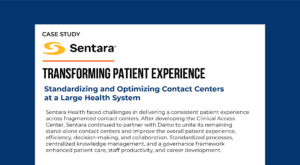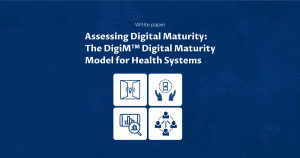How the COVID-19 pandemic is reshaping healthcare with technology
It’s a remarkable story that is playing out in the technology-led enablement at the back end of healthcare organizations, even as the headlines are dominated by the heroic response efforts at the front lines of care.
In one of my recent podcasts, John Kravitz, CIO of Geisinger Health, a leading health system with 11 campuses and 13 hospitals in Pennsylvania, speaks about how the organization’s leaders have been “blown away” by how technology has stepped up to help address the COVID-19 crisis. Geisinger’s IT organization has kept up with a 500% increase in telehealth visits and a doubling of remote workers to 13,000 employees.
Here’s a look at how stories like Geisinger’s are playing out across the country and how digital technologies are reshaping care delivery in the short and longer-term.
The sudden upscaling of virtual care capacity
Front line healthcare workers have been swamped since the coronavirus outbreak by the number of calls from patients who want to speak with their doctors about possible symptoms for COVID-19. Many health systems are turning to self-triaging tools to help consumers check for symptoms before asking to be put through to a doctor. Providence Health in Washington State, which was Ground Zero for the pandemic in the US, has reconfigured their chatbot Grace with FAQ’s and assessments related to COVID-19 symptoms. Sara Vaezy, Chief Digital Strategy Officer at Providence Digital Innovations Group, states that they saw 70,000 patient logins and over one million messages come in through the chatbot in the first month of the outbreak. To put the numbers in perspective, virtual visits were 10-15 times more than pre-pandemic levels.
However, the challenge doesn’t end there. Patients who get triaged for COVID-19 screening have had to wait in a virtual queue because of the sudden spike in the number of virtual visits. The lack of available trained clinicians to take on virtual consults has exacerbated the problem (my daughter, who lives in Chicago had to wait for a day for a video visit with her doctor after coming down with a cold). To address the surge, Providence Health redeployed their same-day Express Care clinicians to attend to the newly triaged patients coming in through the chatbots. Elsewhere in the country, health systems are going through some variation of this scenario. As health systems streamline their processes and bring more clinicians on board, the learning curve will flatten out as will, eventually, the intake volumes as we climb out of the pandemic.
Not all online triaging tools are seeing the same levels of success. Silicon Valley tech firms, always quick to respond with technology to marketplace needs, have seen a lukewarm response to new tools by startups and big tech firms. Google parent Verily’s symptom triaging tool for COVID-19 came under criticism from privacy advocates, highlighting the lack of trust that epitomizes the challenges for digital health companies in general.
The mainstreaming of Telehealth
Out of every crisis, a new opportunity arises. For telehealth, it may be an opportunity whose time has finally come. The volumes of telehealth consults have gone up several multiples since the pandemic struck. John Kravitz of Geisinger Health has seen a 500% increase in telehealth visits within the first couple of weeks since the outbreak. In anticipation, Geisinger has trained over 1000 providers (and counting) on conducting telehealth visits with patients. Telemedicine platforms are also enabling patient families to speak with their loved ones in acute care. While most health systems seem to have successfully scaled up their telehealth operations, some have seen a rise in wait times that have negated the premise of “on-demand” care through virtual health tools. Others, such as Cleveland Clinic, have seen the technology struggle to keep up with a 10x increase in volumes.
The use of telehealth has been growing in the past few years, though more slowly than expected. One major cause has been the lack of a reimbursement model for telemedicine that puts it on par with in-person visits. Recognizing the need to promote telehealth as a public health and safety issue, the Government has brought reimbursements for telehealth on par with other visits. We may be seeing a tipping point that takes telehealth mainstream in one stroke, transforming the way we experience health care in the future. Most importantly, the public at large will get used to telehealth visits as an acceptable way of obtaining health care for low-acuity needs.
A related area of growth has been remote patient monitoring (RPM) and home monitoring. While RPM has grown steadily in the past couple of years, the current shelter-at-home restrictions across the country have highlighted the need to monitor patients with chronic conditions in their homes. Patients Under Investigation (PUI) who are suspected of having been infected with COVID-19, are also being monitored closely, as are others who are worried about their risks (the “worried well”).
The Coronavirus crisis may be a tipping point if we look across time horizons for the future of healthcare, for how we live and work, and even the future of the planet.
Digital transformation will accelerate
Some degree of reprioritization of ongoing enterprise IT projects is inevitable under the current circumstances. However, many health systems, such as UPMC and Geisinger Health in Pennsylvania, are accelerating their digital transformation roadmaps, encouraged by the success of telehealth in responding to the crisis and also sensing a fundamental shift in health care delivery. My firm’s work with leading health systems confirms this trend. Healthcare organizations are intensifying their focus on strategic planning for a digital future and are preparing themselves to be ready to launch new initiatives when the crisis passes.
Cybersecurity risks will rise in the short term
Most health systems have managed to stay ahead of cybersecurity attacks so far during the pandemic. However, it is a matter of time before cybercriminals swoop in to take advantage of heightened vulnerabilities. Earlier in March, the Champagne-Urbana Public Health District in Illinois was hit by ransomware and paid $350,000 to regain access to its website. The World Health Organization, The Dept of Health and Human Services, and several state and local agencies have been targeted. Health systems that have seen a doubling of their remote workforce have had to enable staff with Virtual desktop interfaces (VDI) and connectivity devices to connect to enterprise IT systems seamlessly with minimal data flow between devices in and outside firewalls. However, despite strong endpoint security, this large-scale shift to a virtual workforce also exposes new vulnerabilities waiting to be exploited.
How we live and work may have changed forever
If we take a slightly longer view, the tipping point we are experiencing is playing out through how companies are reorganizing their workforce around virtual workplace models, using video-conferencing and other virtual collaboration tools. As employees and employers get serious about maintaining productivity and effectiveness in the current crisis, companies and public health agencies will apply the learnings from the present crisis to find ways to repurpose existing assets in preparation for the next crisis. Across the land, hotels are turning into makeshift hospitals; sport and concert arenas are turning into logistics hubs. What’s to stop the Government from mandating building codes that require a degree of “repurposability” in the future?
The benefits to society from such a shift may be even more profound. Reduced travel and commutes will reduce carbon emissions, paving the way for a reversal of climate change. Think this is too far-fetched? Check out this dramatic visual of air pollution levels in China before and after the coronavirus outbreak.
The future is here but is unevenly distributed, as someone said. The upsides from the crisis will seem minimal to the airline industry as it deals with grounded airplanes. The rise of telehealth will mean little to the local economy in Orlando that would have relied on the HIMSS2020 healthcare IT conference that would have brought 50,000 delegates to the city in March; the Ubers and Lyfts, the concession stands, the hotels and restaurants, not to mention the convention center and the event staff. Our fellow humans in the margins of society may have to bear a disproportionate burden from the devastating health and economic impacts of the crisis. The worst may be yet to come. But the best may be, too.
Originally published on CIO














